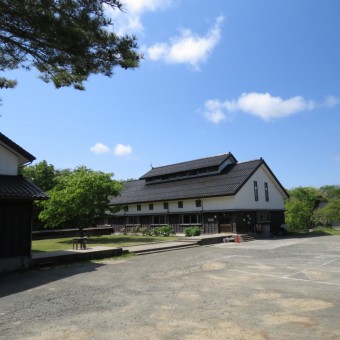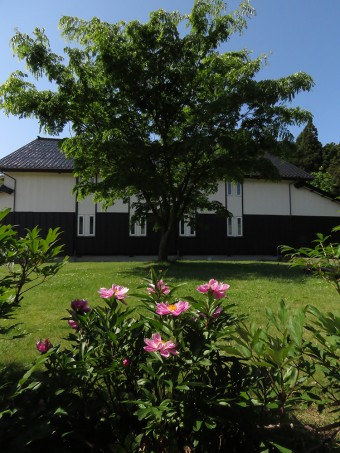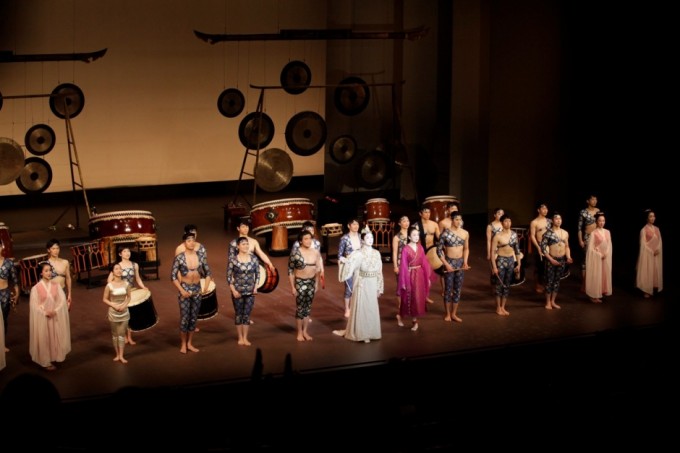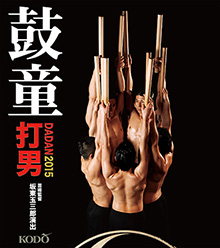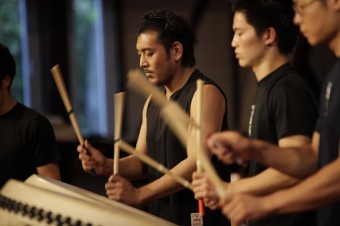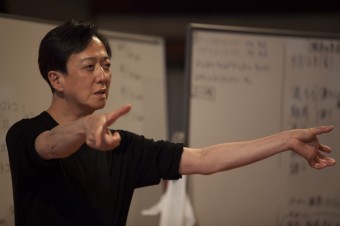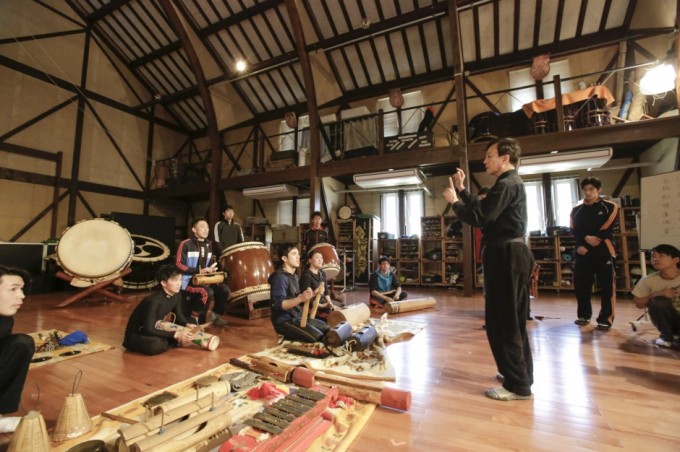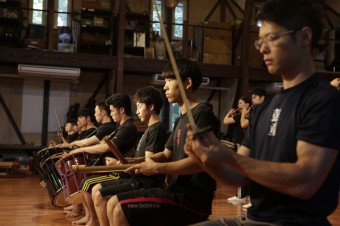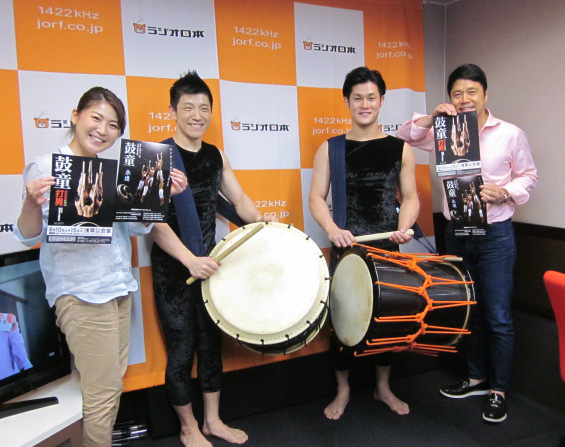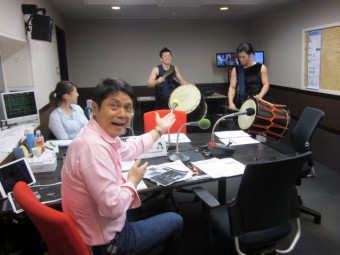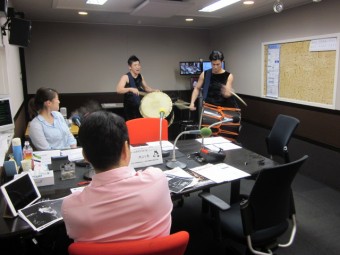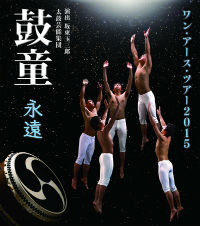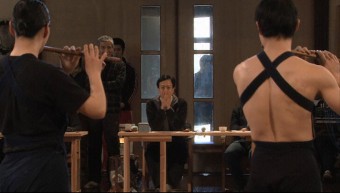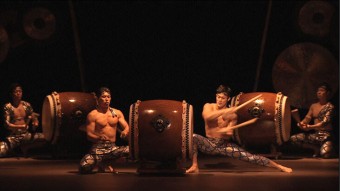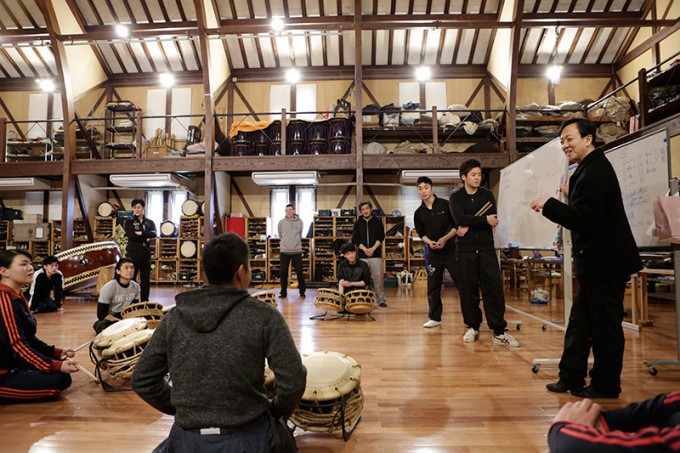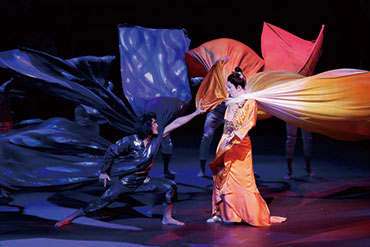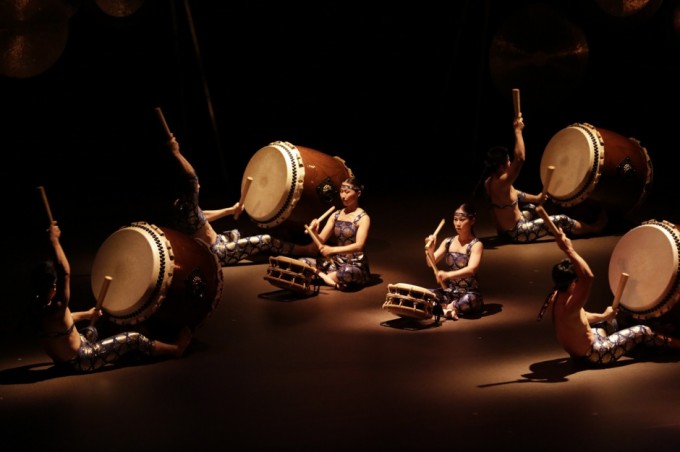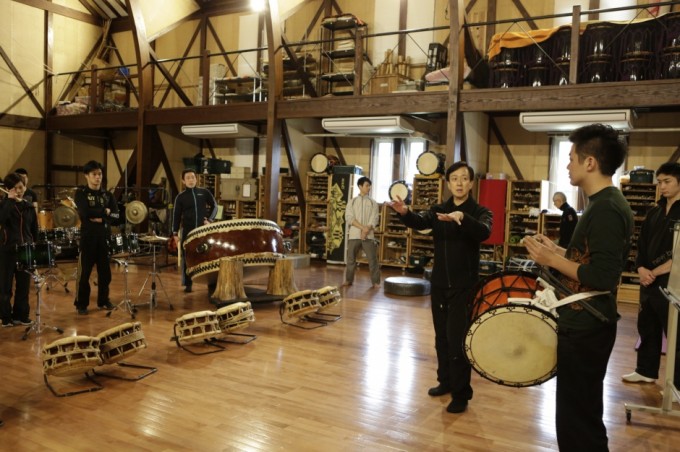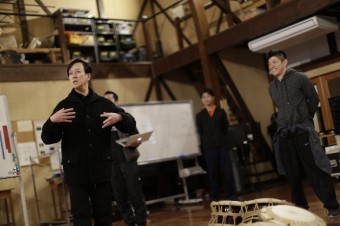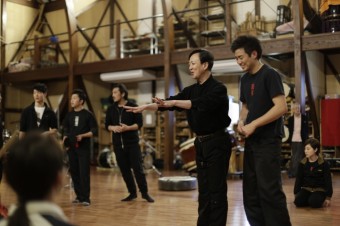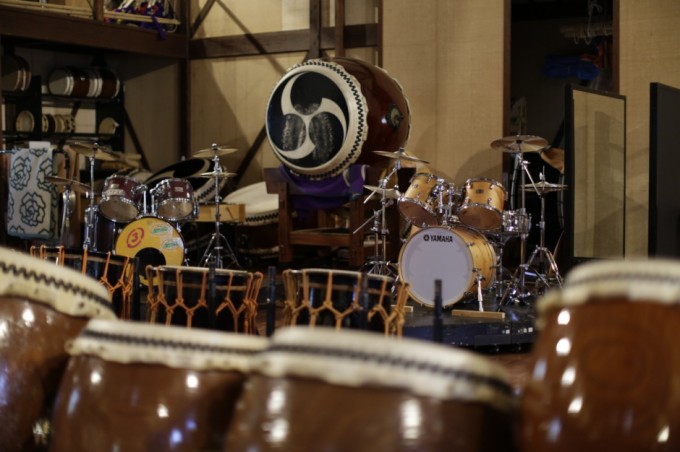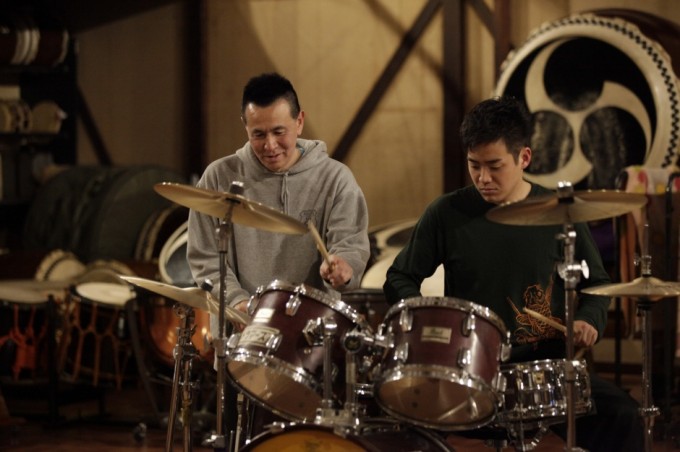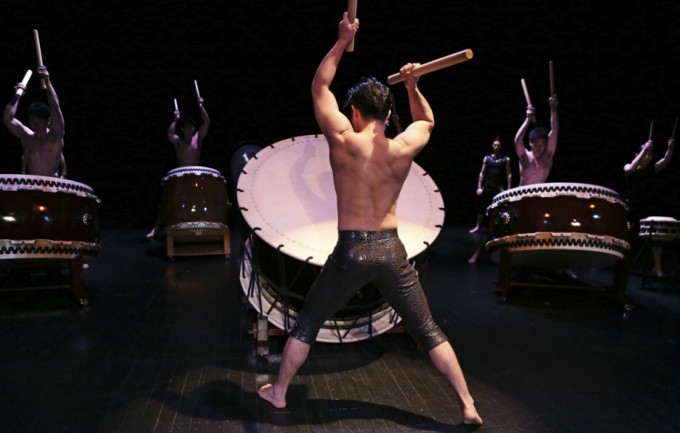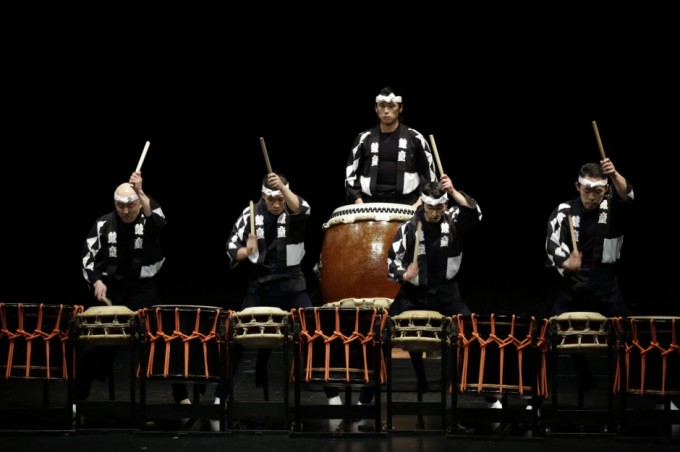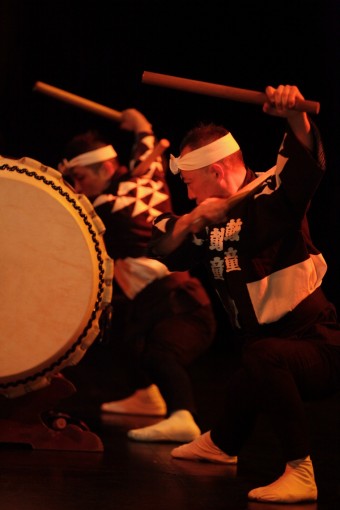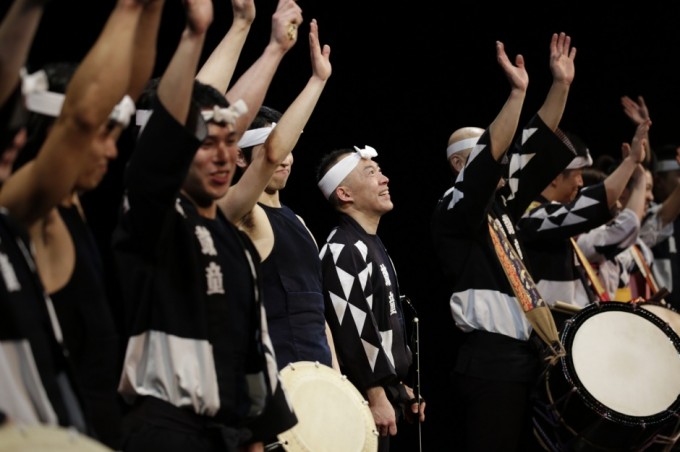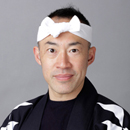Tag ‘Kodo One Earth Tour’
“Kodo in June” by Tomohiro Mitome
June 1, 2015
Hello, everyone! I hope that you are well.
This is Tomohiro Mitome, leader of taiko performing arts ensemble Kodo.
June has begun. The sun’s rays are getting stronger and the forests on Sado are such a vivid green. I feel the power of Mother Nature through this intensity.
Until a few years ago, I spent spring traveling around Japan with the “Kodo One Earth Tour” performances, from the beginning of May until the end of June. When I would come back to Sado in June, I was always taken aback by the changes in nature between my departure and my return. As we passed through the dense gauntlet of trees to reach Kodo Village, I’d feel at home before we had even arrived.
Thanks to all of your support, May concluded on a high note after our successful “Amaterasu” performances at Shochiku-za Theatre in Osaka. Thank you very much to all of you who attended the performances. The previous encore performances were held two years ago, so this time even more young, new members joined the cast. I think “Amaterasu” provided them with such valuable experiences: they rose to the challenge of tackling new parts and instruments, and they were able to perform on stage with Kabuki luminary Tamasaburo Bando.
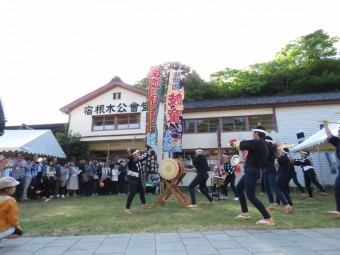
Around the same time, we held the fourth annual “Kodo Special Performances on Sado Island” near Kodo Village in the historic Shukunegi area. The cast was centered around Kodo’s distinguished members and also featured our new junior members, so there was a large age gap between the cast members (more than a generation!). These performances were a great opportunity for our junior members to learn from our senior members.
As usual, from June Kodo has planned a variety of performances in Japan including “Kodo One Earth Tour 2015: Eternity” performances and “School Workshop Performances.”
From June 10 to 15, our “DADAN 2015” performances will take place at Asakusa Public Hall in Tokyo. This year is the third year for Kodo to have a series of performances at Asakusa Public Hall in June. Thanks to warm local support, Kodo’s performances in Asakusa have gradually started to take root.
Kodo Rehearsal Report: “Eternity,” the Origin of Kodo and Taiko –Part 4–
“Eternity,” the Origin of Kodo and Taiko –Part 4–
Original Japanese Article by Koichi Imai (Freelance Writer) ● Photos by Takashi Okamoto
Accumulated Knowledge and Experience: Harnessing Knowledge Towards New Discoveries, Kodo Style

Kodo members not only harness the power and allure of the taiko, they find something new that transcends the taiko itself, and it is this indescribable experience that they share with the audience. That is a depiction of “eternity.” Once again, they revert to their purest selves as they face the taiko. After taking the time to analyze the taiko in all of its sounds and possibilities, they discard everything they know and start all over again in search of something new. In “Eternity,” the O-daiko (big drum), which used to be a requisite symbol of Kodo that typically marked the climax, never even appears on stage. But I do not find this the least bit strange. In its stead, various taiko conjure a wealth of other expressions, some of which do not sound like taiko at all. That is what makes a strong, tenacious taiko performance stand out and lets the performers move us. At the same time, I feel the amazing power of Kodo’s accumulated history, methodologies, experiences, and environment spanning over thirty years. One of the group’s challenges is also to find new meaning in these things.
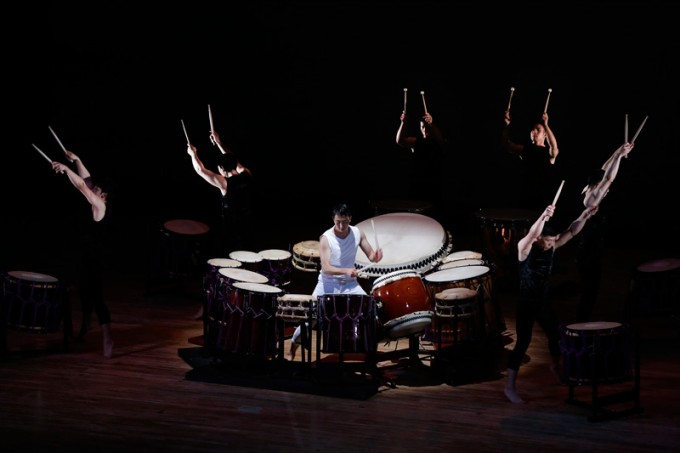
“We have been trying all manner of things since Tamasaburo (Bando) became our artistic director, no matter what people said,” explains Masayuki Sakamoto. “I hope that people come to consider what we do as a whole as a ‘Kodo performance,’ not to label it as new or old. I hope that we can find our voice equally in traditional pieces as well as fields such as contemporary dance.”
Kodo Rehearsal Report: “Eternity,” the Origin of Kodo and Taiko –Part 3–
“Eternity,” the Origin of Kodo and Taiko –Part 3–
Original Japanese Article by Koichi Imai (Freelance Writer) ● Photos by Takashi Okamoto
“What is Wadaiko?”: This Simple Question Opens Doors to New Possibilities
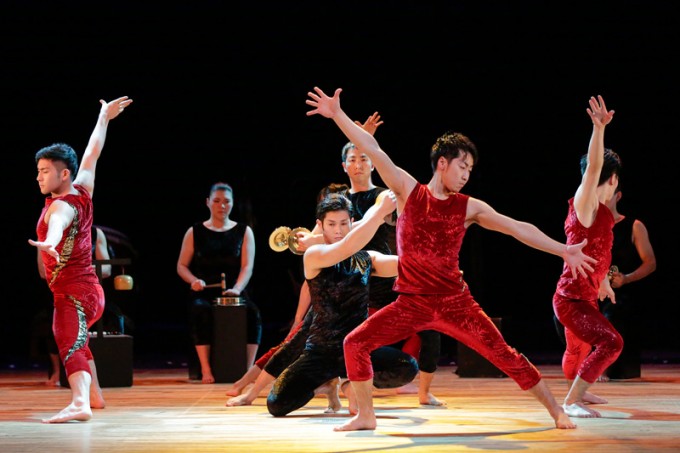
The second half of “Eternity” also started with the orin gong. This perhaps acts as a charm to transport the audience into another world. An ensemble of chappa (small cymbals) and bells are played at the opening. Four performers slip out of the ensemble to begin dancing in an arrangement that feels at once ancient and contemporary. They invite the audience to enter another dimension along with the mysterious melody of the chappa and gamelan (Indonesian percussive instruments).
Transported to another dimension, you encounter Takibi (composed by Yosuke Oda). It is a very unique piece, which will shatter your established ideas about taiko. Five performers trace the rims of the taiko with their drumsticks as they draw circles, tapping them as they go around. It is in using every element of the taiko like this that they are able to create sounds and rhythms beyond traditional taiko. At risk of being misunderstood, I would almost say I feel like I am at a “Stomp” performance, in which the players use brooms and metal drums as musical instruments. I can’t believe that I am listening to the taiko. It is well known that Stomp was heavily influenced by Kodo, and it is in this moment I understand that Kodo represents one of the top percussion performances in the world and the taiko has tremendous possibilities.
“When I thought of ‘eternity,’ I felt the need to travel backward in time,” explains Yosuke Oda. “Eternity spans not only into the future, but also the past. So I tried to imagine taiko before its present playing style was established and decided not to use common taiko rhythms. Some people today may say that what we are playing is not ‘taiko,’ but no one knows how the instrument was actually played in ancient times. The idea of ‘common’ taiko playing was made after a basic taiko style had been constructed.”
Oda arrived at this idea through his experiences in “Legend” and “Mystery,” once he had grasped what the Artistic Director, Tamasaburo Bando, was hoping to achieve. Tamasaburo’s ideas could be similar to those that he applies in Kabuki, not only as a traditional performance, but also as a modern form of expression. When Oda, who is a core figure in the Kodo ensemble, comes up with such a liberated idea, it is bound to have great influence on other members.
Kodo Rehearsal Report: “Eternity,” the Origin of Kodo and Taiko –Part 2–
“Eternity,” the Origin of Kodo and Taiko –Part 2–
Original Japanese Article by Koichi Imai (Freelance Writer) ● Photos by Takashi Okamoto
Orders from the Artistic Director Help Us Rediscover the Allure of Taiko
This particular run-through rehearsal was held in the middle of September 2014. The atmosphere was slowly changing from the summer air of Kodo’s outdoor festival “Earth Celebration,” held between August 21 and 23, into an autumnal mood. But despite the cool winds blowing outside, the rehearsal hall at Kodo Village was warmed by the energetic rehearsals for “Kodo One Earth Tour: Eternity.” As the Kodo performers had been scattered all over the world on separate tours in the months prior, rehearsals in which all members were present were extremely rare and the level of concentration was intense. “Let’s use all new pieces for this programme,” said Artistic Director Tamasaburo Bando, and that’s how everything for “Eternity” started in January 2014. Until then, Kodo had mostly assembled or arranged their tried-and-tested pieces to form a programme, but “Eternity” was not created in this way: Instead, it began from scratch.
The Kodo members were invited to share their visions of “Eternity,” and discuss these as a group. “We shared ideas and talked together a couple of times,” explains performer Yuichiro Funabashi. “Some of the ideas were in the form of music, others members had ideas about how the taiko should be played or the positioning of the instruments; it could have been anything. Then Tamasaburo took these ideas and began to build the programme. He arranged some ideas into new pieces, used parts from others, and thus the programme developed.” Afterward, the “seeds” the Artistic Director planted had to be nurtured by the Kodo members, and the overall vision for the programme became clear at the beginning of September.
Kodo Rehearsal Report: “Eternity,” the Origin of Kodo and Taiko –Part 1–
“Eternity,” the Origin of Kodo and Taiko –Part 1–
Original Japanese Article by Koichi Imai (Freelance Writer) ● Photos by Takashi Okamoto
When I first visited Sado Island, I was impressed by the powerful sun setting beyond the horizon. This autumn, a new Sado Kisen Car Ferry had just been christened the Akane, which means “powerful red,” an image that perfectly captured the essence of that sunset. The name also calls to mind the toki (Japanese crested ibis), a protected species of bird raised with deep care and affection on the Island. I remember thinking that the sunset on Sado captured all of the island’s brilliant natural splendor at once; somehow it was much more dramatic on that day than any other.
While I was watching the rehearsal of Kodo’s new programme “Kodo One Earth Tour: Eternity,” this same feeling came to mind. The rehearsal had a nostalgic feel, like an autumn festival from days past. The warm sounds of the drum and the warmth of the sun setting behind the stage seemed to capture the essence of Sado completely.
By any measure, “Eternity” is a profound and epic title.
Artistic Director Tamasaburo Bando explains this choice as follows:
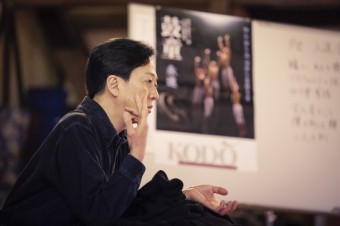
“When I was contemplating the theme of eternity, it occurred to me that ‘the workings of nature’ unfold in cyclical patterns, and that perhaps in identifying those patterns, we could express ‘eternity.’ Strictly speaking, there is probably no such thing as ‘eternity,’ for us mortals, but there are some things that are eternal. The dawn, light, rain, wind, clouds, waves, stars, dusk, the night sky; and amongst all these, I saw ‘human beings.’”
The Rehearsal Hall: A Forum for Trial and Error Filled with Heart, Sounds, and Smiles
The workings of nature have enormous power that cannot be fathomed nor controlled by human intellect. A mysterious life force resides in even the tiniest buds. Perhaps eternity can be found in the different sounds of the taiko used to express the workings of life itself.
The opening piece, Yogiri (composed by Tsuyoshi Maeda), introduces the drama about to unfold as it spreads out into the darkness like a giant projection screen. The high-pitched tone of the orin (Buddhist altar bell) echoes like a cool wind blowing across the Island. Shinobue (bamboo flute) melodies call to mind the musical accompaniments of the autumn festival mentioned above, as various percussion instruments beat the base rhythm. This combination conjures an air of nostalgia for a time gone by, when repeated patterns somehow wove the fabric of our daily lives. At the same time, the sounds of waves and wind intertwine. The lasting effect of this piece is an appreciation of the richness of the nature– the ocean, mountains, et al– on Sado Island.
Our Appearance on Radio Nippon “Mine Ryuta no Minesta”
Radio Nippon “Mine Ryuta no Minesta”
Today Yuichiro Funabashi and Masayuki Sakamoto made a live appearance on Radio Nippon’s weekday morning program “Mine Ryuta no Minesta” during the “Talk with Mr. Mine” corner. Thank you very much to everyone who tuned in! We hope you’ll come to hear them perform live at a theater sometime soon, too!
With radio personalities Ryuta Mine (far right) and Ai Handa (far left)
Live performance of SHAKE
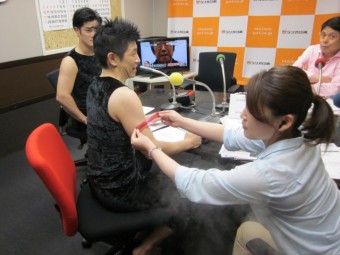
Ms. Handa used a ruler to measure Yuichiro’s muscles…?!
▼For more about today’s appearance, have a look at the radio program’s blog (in Japanese).
“Mine Ryuta no Minesta” Program Blog
http://giants.jorf.co.jp/minesta/2015/05/post-a7bf.html
Photos courtesy of Radio Nippon
June 2015 “DADAN” in Asakusa, Tokyo
http://www.kodo.or.jp/news/20150610dadan_en.html
June–July, Sep.–Oct. 2015 “Kodo One Earth Tour: Eternity” Japan Tour
http://www.kodo.or.jp/news/20150606oet_en.html
[May 24] TV Broadcast: BS Fuji “Kodo Eien no Hibiki” (Kodo, Echoes of Eternity)
[May 24] BS Fuji Broadcast of “Kodo Eien no Hibiki” (Kodo, Echoes of Eternity)
Tune in on May 24 for a 30-min. program introducing “Kodo One Earth Tour: Eternity,” which will tour around Japan from June. It is a new version of the 2014 program with the same title, featuring new interviews and stage footage.
If you’re in Japan, we hope you’ll tune in!
Broadcast Date & Time: May 24 (Sun) 12:00—12:30
Broadcast Channel: BS Fuji
Program Website: BS Fuji “Kodo Eien no Hibiki” http://www.bsfuji.tv/top/pub/kodou.html
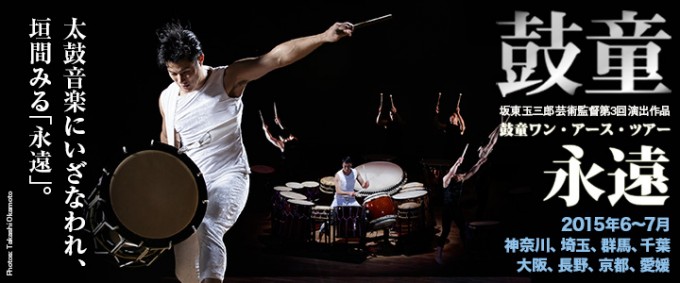
About “Kodo One Earth Tour 2015: Eternity”
“A Season of New Buds” by Tomohiro Mitome
May 1, 2015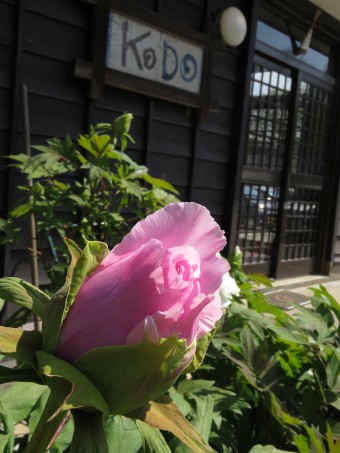
Hello, everyone! I hope that you are well.
This is Tomohiro Mitome, leader of taiko performing arts ensemble Kodo. May is here and it is a very comfortable, refreshing season. Flowers are bursting into full bloom and I feel so energized by spring.
As usual, April for Kodo was a time for us to hold rehearsals for the next new “Kodo One Earth Tour” production, which will premiere on Sado this November. We also rehearsed for “Kodo One Earth Tour: Eternity” and the School Workshop Performances, which resume their tours in Japan in June, as well as the “Kodo Special Performances on Sado Island,” and other projects. Much like the cycle of the nature, this is a season at Kodo when new buds emerge and grow.
This May, we will hold encore performances of “Amaterasu” at Shochiku-za Theatre in Osaka. “Amaterasu” premiered in 2006, and we also held popular encore seasons in 2007 and 2013.
This production is a rare opportunity for Kodo to collaborate on stage with our artistic director, Tamasaburo Bando. This year, we welcome back guest artist Harei Aine and look forward to sharing a new version of this performance with our audiences. In this production, we convey the story of a famous Japanese myth using the myriad sounds of Japanese musical instruments, ranging from raging gods, using the powerful roar of the taiko, to one scene where “eight million gods” gather for a party.
The party reaches its climax with a dance by a goddess called Ameno-uzume (performed by Harei Aine), which leads to the appearance of the dazzling sun goddess, Amaterasu, who emerges from the heavenly rock cave. That moment creates such a powerful wave of energy that even as performers on the same stage, we cannot help feeling moved by it as we play our taiko. It is a truly precious moment. I hope you won’t miss the opportunity to see this performance live!
“Rehearsals for Brand New Production ‘Chaos'” by Yuta Sumiyoshi
Apr. 27, 2015
Rehearsals for Brand New Production “Chaos”
Our rehearsals began with a talk from artistic director Tamasaburo Bando about the new production’s title, “Chaos.”
While the title is “Chaos,” Tamasaburo said he wants the audience to feel “harmony” when they come to this performance. If he called it “Harmony,” noone would know where that harmony would occur. Harmony has somewhere to emerge from somewhere, so you need chaotic parts. As he explained the concept to us, he jokingly admitted that this might be a humble Japanese form of expression.
This production features Japanese drums (wadaiko), naturally, but it also incorporates Western drumkits.
“A New Season Begins” by Tomohiro Mitome
Apr. 1, 2015
Hello, everyone! I hope you are well.
This is Tomohiro Mitome, leader of taiko performing arts ensemble Kodo.
Now that it’s April on Sado Island, spring has arrived and buds are appearing on the branches of the cherry trees.
In Japan, both the new work year and school year start in April.
At Kodo, it’s the time of year when we welcome new apprentices. The Year 34 class are about to arrive at the Kodo Apprentice Centre to start their lives as apprentices. I am sure they will all head to Sado with high expectations, some apprehension, and huge dreams.
Our first tour this year, the “Kodo One Earth Tour 2015: Mystery” North America Tour, concluded successfully thanks to all of your support. I would like to express our gratitude to all the staff members involved, the presenters, and everyone who attended our performances.
The Kodo members that remained in Japan spent March giving a variety of small-ensemble and solo performances in so many places. On March 15, we even had 4 different performances in 4 different places at the same time: Iizaka in Fukushima, Kurashiki in Okayama, as well as Seiro and Joetsu in Niigata. The performers and staff were hurtling around Japan at a great pace.
Also, we had Kodo Special Performance 2015 “Michi” at Kanagawa Arts Theatre (KAAT) in Yokohama, Kanagawa Prefecture, on March 19 & 20. Although these two performances were held on weekdays, we were greeted by full houses on both dates. I believe that the programme was nostalgic for long-time Kodo fans and supporters, yet would have felt brand new to audiences who started to attend Kodo performances in recent years.
By presenting an orthodox “Classic Kodo” programme with new members, I am confident that we were able to produce a whole new work, not just an “encore” performance. During our rehearsals, all the performers had the chance to see what makes us “Kodo,” or what Kodo holds dear, in a new light: how to perform, how to change sets (instruments and stands) between pieces, how to walk on stage, and so on. While recognizing all of this anew, the senior members were able to hand these core elements down to the younger, next-generation members. The newer members did their best to absorb the valuable knowledge and experience shared by the senior members, which they had accumulated over the years.
While maintaining our core, the foundations Kodo has forged over the past 34 years, it is vital for the current Kodo ensemble to gain new strength so we can survive in a new era. The new forms of expression we are exploring now are very important because they will help Kodo to evolve and continue its activities for many years to come. I think the fruits of this special performance, “Michi,” will also become apparent in the future. I hope that we can continue to provide opportunities for you to experience the core and roots of Kodo in various forms of expression.
In April, all the Kodo members return to Sado Island and gather for rehearsals. We will work hard together as we create brand new productions and prepare for “Amaterasu” and our upcoming tours. We look forward to sharing them with you on stage soon.




